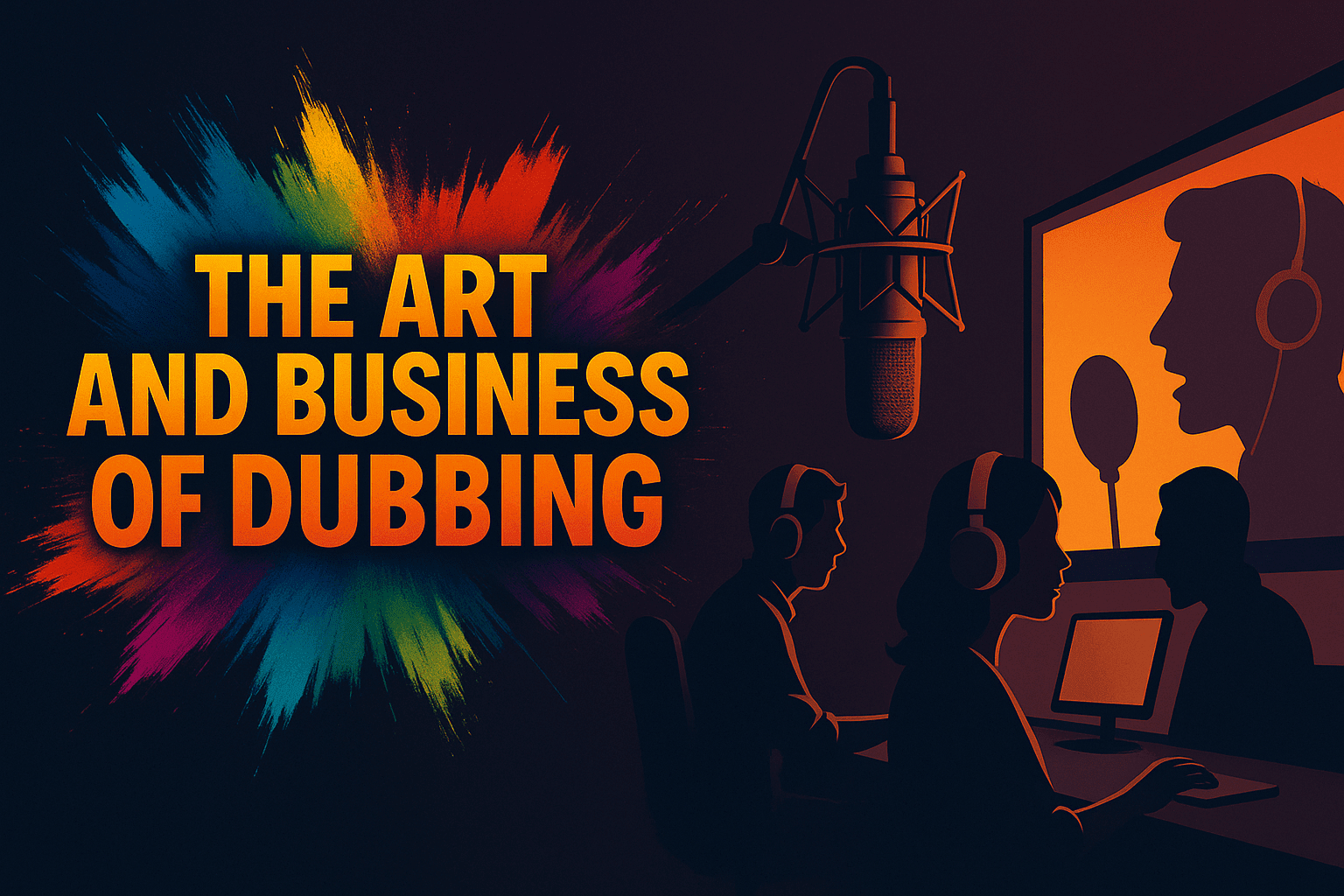The Art and Business of Dubbing: A 2025 Executive Guide to the Post-Production Process

Introduction
In the globalized media landscape of 2025, reaching a worldwide audience is no longer an ambition—it is a baseline requirement. For senior media and entertainment executives, the strategic challenge is not simply producing content, but ensuring that content resonates across languages and cultures.
This is where the meticulous and often misunderstood process of dubbing becomes a critical component of the entertainment supply chain.
Beyond a simple translation, professional dubbing is a complex, multi-layered post-production discipline that requires a fusion of linguistic precision, artistic performance, and technical mastery.
It is the art of completely replacing a project’s original dialogue with a new, localized performance while maintaining the integrity and emotional core of the original work.
Table of content
Key Takeaways
| Core Challenge | How can M&E executives ensure their content localization strategy is effective and maintains creative integrity in a rapidly expanding global market? |
| Strategic Solution | A deep understanding of the end-to-end dubbing process, from the initial script adaptation to the final mix, to make informed vendor and technology decisions. |
| Vitrina’s Role | Vitrina provides the data and intelligence needed to discover, evaluate, and connect with vetted localization and post-production partners globally. |
Demystifying the End-to-End Dubbing Process
The process of dubbing has a rich history, evolving from the early days of silent film intertitles to the complex, digital workflows of today. In the 1930s, studios would often shoot multiple versions of a film with different casts for international markets, a strategy that was both expensive and inefficient.
It was the rise of sound in film that made true dubbing a necessity, leading to the sophisticated, multi-track audio engineering we know today. Now, content creators and distributors are under immense pressure to localize content rapidly to meet the demands of global audiences on streaming platforms.
At its core, how does dubbing work? The dubbing process is a precise post-production workflow that replaces the original audio with a new voice track, meticulously synchronized with the on-screen visuals.
This is not simply about translating words; it involves adapting cultural idioms, matching emotional tone, and ensuring the new dialogue aligns with the actors’ lip movements and facial expressions.
This level of detail is what separates a quality dub from a distracting one, allowing a story to feel native to its new market.
The Key Players in the Dubbing Supply Chain
A successful dubbing project is a collaborative effort involving a range of highly specialized professionals and technology platforms. This intricate supply chain is managed by a dubbing studio or a larger localization house.
The key players in this supply chain each have a specific function that is critical to the final output. The Translator/Adaptor’s role extends far beyond literal translation; they are tasked with adapting the script for the new language, ensuring cultural relevance, and making sure the new dialogue fits the on-screen action, a process known as lip-syncing.
The Casting Director is responsible for sourcing the right voice talent to match the tone, pitch, and character of the original performance, which is a subtle and essential art form.
The Voice Actor must deliver a performance that captures the emotional nuance of the original while adhering to the technical constraints of the adapted script and the on-screen timing.
The Dubbing Director’s job is to guide the voice actors’ performance, ensuring consistency in tone and delivery. Finally, the Sound Engineer is the technical master of the process, recording, editing, and mixing the newly recorded dialogue with the original music and effects (M&E) track to create a seamless final mix.
How Dubbing Works: A Strategic Breakdown
The modern dubbing workflow is a multi-step process that requires careful planning and execution. From an executive’s perspective, understanding this sequence is vital for accurate timeline management and quality control.
The process begins with the original script, which is received by the translation team along with a “spotting list” of time codes for each line. The first challenge is translating and then creatively adapting the script to make the new lines fit the on-screen lip movements and rhythm.
This adaptation is a meticulous process that can be a major challenge when translating between languages with different sentence structures or phonetics. With the adapted script, the casting director finds the right voice talent, a critical factor in a successful dub, and the dubbing director guides their performance to mirror the original actors’ emotions.
The recording takes place in a professional sound studio, where voice actors perform their lines while watching the original footage. This part of the dubbing process is highly technical, with sound engineers ensuring crystal-clear audio quality.
A common technique, known as automated dialogue replacement (ADR), is used both for foreign-language dubs and for replacing unclear original dialogue. After the dialogue is recorded, it is edited to align perfectly with the on-screen action.
The final and most important step is the mix, where the new dialogue track is blended with the original music and effects (M&E) track.
This is a sensitive balancing act, as the new dialogue must feel completely natural within the original soundscape. After the mix, a rigorous quality assurance (QA) process begins, with the dubbed version reviewed by linguists and native speakers before it is considered complete.
The Crucial Distinction: Dubbing vs. Voice-Over
The terms “dubbing” and “voice-over” are often used interchangeably, but they refer to two distinct localization methods. For executives, knowing the difference is key to a cost-effective and creatively sound strategy.
Dubbing is the complete replacement of the original dialogue. The goal is a seamless, immersive experience where the audience forgets they are watching a translated work.
It requires meticulous lip-syncing and a performance that mirrors the original in tone and emotion, and is typically used for narrative content like feature films and TV series. In contrast, voice-over is a secondary audio track laid over the original dialogue, which is still audible at a lower volume.
It is less concerned with lip-syncing and more focused on conveying information. This method is often used for documentaries, news reports, or interviews, where the authenticity of the original voices is part of the experience.
Choosing between the two depends on the content, target audience, and budget. While dubbing offers a more premium, immersive experience, voice-over provides a faster, more cost-effective alternative for informational content.
The rise of AI dubbing and speech synthesis tools may blur this line in the future, but for now, the distinction remains critical.
How Vitrina Helps Find the Right Dubbing Partners
With the global demand for localized content at an all-time high, the challenge for M&E executives is finding the right partners to execute a high-quality dub.
The market for dubbing services is fragmented, and it is a pain point for executives to identify reliable, vetted vendors with the right specializations, whether it’s for a specific genre, budget, or language.
Vitrina.ai is a strategic solution designed to address this challenge. It provides a comprehensive, unified view of the global media and entertainment supply chain.
With Vitrina, you can go beyond basic searches to find and evaluate verified localization and dubbing companies based on a granular set of criteria. The platform’s real-time project tracking and company profiling capabilities allow you to discover partners who have worked on similar projects, have the right credentials, and are known for their expertise.
This intelligence transforms a previously manual and opaque process into a data-driven one, helping executives discover, validate, and connect with the best vendors to meet their business goals.
Conclusion: Localization as a Growth Engine
Understanding how the dubbing process works is more than an academic exercise—it is a strategic imperative. As global streaming continues to dominate the entertainment industry, the ability to effectively and efficiently localize content is a primary driver of market share and revenue.
Dubbing is a complex art and science that requires a deep bench of skilled professionals, from linguists to sound engineers. By embracing a data-driven approach to partner discovery and vendor management, executives can move beyond traditional, fragmented methods.
Platforms like Vitrina allow you to make smarter, more informed decisions about your localization strategy, ensuring your content not only reaches new markets but truly resonates with them.
In 2025, a successful localization strategy is not just about expanding your reach; it is about building a truly global brand and a pipeline for future growth.
Frequently Asked Questions
Dubbing is the complete replacement of a film’s dialogue in a different language for a foreign audience. ADR, or Automated Dialogue Replacement, is a similar technical process of re-recording dialogue, but it is used to fix or replace original dialogue in the native language, often due to poor on-set audio quality.
The time required for dubbing can vary widely based on the project’s length, the number of languages, and the complexity of the content. A typical feature film can take several weeks to a few months to complete, including translation, recording, and mixing.
AI is increasingly being used to automate parts of the dubbing process, from initial translation to voice synthesis. While AI-powered tools can accelerate workflows and reduce costs, human expertise remains critical for the nuanced artistic and cultural adaptations required for a high-quality, emotionally resonant dub.
An M&E track is a version of a film’s soundtrack that contains all the non-dialogue audio, including music, sound effects, and ambient noise. This track is essential for dubbing, as it allows the new dialogue to be mixed seamlessly with the original soundscape without re-creating all the audio from scratch.

























